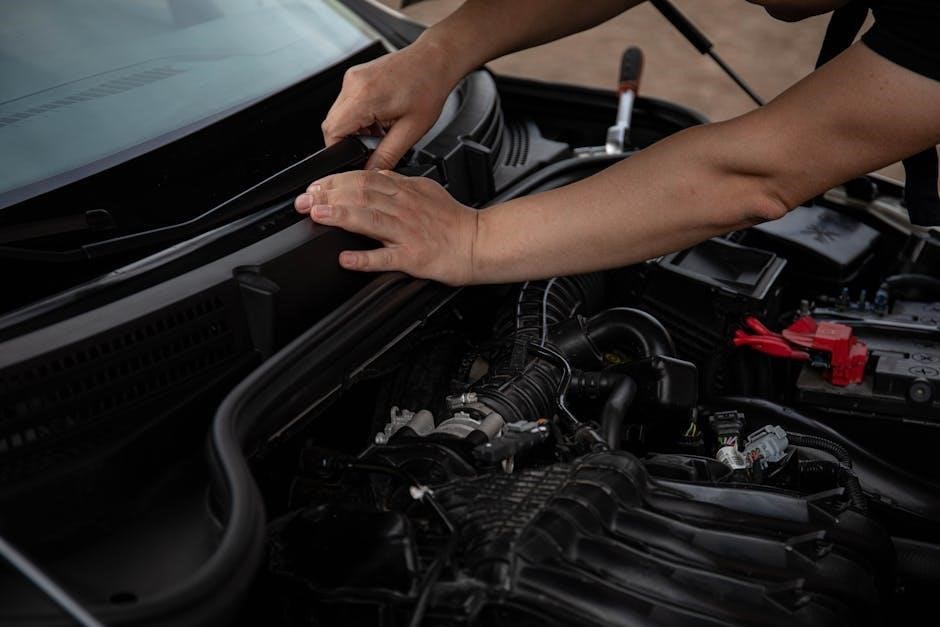Manual wipers are hand-operated windshield cleaning systems designed to clear rain‚ snow‚ and debris from vehicle windshields. Known for their simplicity and cost-effectiveness‚ they remain a practical choice for many drivers seeking reliable and straightforward windshield maintenance solutions.
1.1 Definition and Purpose
Manual wipers are hand-operated windshield cleaning systems designed to clear rain‚ snow‚ and debris from vehicle windshields. They consist of a wiper blade attached to an arm‚ which is moved manually to sweep the glass. Their primary purpose is to improve visibility and safety by maintaining a clear windshield‚ especially in adverse weather conditions. They are simple‚ cost-effective‚ and easy to maintain.
1.2 History and Evolution
Manual wipers have a long history‚ dating back to the early 20th century when windshield wipers were first introduced. Initially‚ they were simple‚ hand-cranked systems. Over time‚ they evolved into arm-and-blade mechanisms‚ becoming standard in vehicles. Modern designs feature improved materials and ergonomic handles‚ enhancing functionality while retaining their simple‚ cost-effective nature. This evolution reflects ongoing efforts to balance practicality with technological advancements;
Types of Manual Wipers
Manual wipers are categorized into hook arm‚ pin arm‚ and push-button types‚ each designed for specific vehicle models and offering unique installation and operational features.
2.1 Hook Arm Type
The hook arm type is a popular manual wiper design‚ featuring a metal hook that securely attaches to the wiper blade.
To install‚ press the tab on the blade‚ slide it over the wiper arm‚ and release. This type is known for its ease of use and compatibility with most vehicles.
It’s a preferred choice for drivers seeking a straightforward‚ reliable solution for windshield maintenance. Always ensure the size matches your vehicle for proper fit and function.
2.2 Pin Arm Type
The pin arm type manual wiper features a small pin on the wiper arm that inserts into a hole on the blade.
To install‚ align the pin with the blade’s hole and push until it clicks. This design ensures a secure fit and smooth operation.
It is widely used for its durability and ease of replacement‚ making it a common choice for drivers seeking a reliable windshield cleaning solution. Always check compatibility with your vehicle’s wiper arm before installation.
2.3 Push Button Type
The push button type manual wiper is designed for easy installation and convenience. Simply press the button on the wiper arm to secure the blade in place. This type is popular for its simplicity and quick replacement process. It is compatible with most vehicles and offers a durable solution for windshield cleaning. Drivers favor this design for its ease of use and reliable performance.
Installation Guide for Manual Wipers
To install manual wipers‚ ensure the correct blade size‚ park safely‚ and turn off the ignition. Align the blade with the wiper arm‚ remove the plastic protector‚ and secure it firmly. Tighten all parts and check for proper fit and function before use.
3.1 Selecting the Right Blade Size
Choosing the correct blade size for manual wipers is essential for optimal performance. Measure the existing blades or consult your vehicle’s manual to determine the appropriate length. Ensure the new blades match the wiper arm type‚ whether it’s a hook‚ pin‚ or push-button design. Proper fit ensures effective windshield coverage and prevents damage. Always verify compatibility with your vehicle’s make and model.
3.2 Step-by-Step Installation Process
To install manual wipers‚ start by ensuring your vehicle is parked safely and the ignition is turned off. Remove the old wiper blades by pressing the tab and pulling them away from the arm. Attach the new blades by aligning them with the wiper arm and securing them firmly. Ensure they are tightly fastened to prevent loose movement. Finally‚ test the wipers to confirm proper functionality and alignment.

Maintenance and Care
Regular maintenance ensures optimal performance and longevity of manual wipers. Clean blades with mild soap and water‚ and lubricate moving parts to prevent rust and friction.
4.1 Cleaning the Wiper Blades
Cleaning wiper blades involves using a soft cloth and mild soap to remove dirt and debris. Gently wipe the rubber edge and the metal frame‚ ensuring no residue remains. Regular cleaning prevents streaks and maintains clarity. Avoid harsh chemicals‚ as they can degrade the rubber. Dry the blades thoroughly to prevent water spots and ensure smooth operation. Inspect for worn or damaged edges and replace as needed.
4.2 Lubricating Moving Parts
Lubricating moving parts of manual wipers ensures smooth operation and prevents wear. Apply a small amount of silicone-based spray or grease to the hinges‚ pivot points‚ and arm joints. Avoid using harsh chemicals or oil‚ as they can attract dirt. Wipe off excess lubricant with a clean cloth to prevent residue buildup. Regular lubrication enhances durability and maintains efficient wiping performance over time.

Safety Precautions
Always handle manual wipers with care to avoid injuries. Ensure the wiper lever is in the OFF position before servicing. Keep hands clear of moving parts during installation or maintenance. Regularly inspect for worn or damaged components to prevent accidents. Proper handling ensures safe and effective windshield cleaning.
5.1 Handling Electrical Components
When handling electrical components of manual wipers‚ ensure the power supply is disconnected to prevent shocks or short circuits. Always follow the manufacturer’s guidelines for safe installation and maintenance. Use insulated tools to avoid direct contact with live wires. Regularly inspect wiring for damage or wear‚ and replace any faulty components promptly. Safety should never be compromised during any procedure. Proper handling ensures reliability and longevity of the system.
5.2 Avoiding Damage to Windshield
To prevent windshield damage when using manual wipers‚ ensure the wiper lever is in the OFF position before raising the blades. Always park safely and never operate wipers on a dry windshield. Inspect blades for sharp edges or debris and replace worn-out ones promptly. Use the correct blade size and avoid over-tightening‚ as this can scratch the glass. Regular maintenance ensures smooth operation and protects your windshield from unnecessary wear.
Troubleshooting Common Issues
Wiper blade wear and tear is a common issue‚ causing streaks and reduced visibility. Regular inspection for cracks or frayed edges is essential. Replace blades when showing signs of deterioration to maintain effective windshield cleaning. Proper installation and maintenance can extend blade life and ensure optimal performance during harsh weather conditions.

6;1 Wiper Blade Wear and Tear
Wiper blade wear and tear is common‚ leading to streaks and reduced visibility. Regularly inspect blades for cracks or frayed edges. Replace them when showing signs of deterioration. Proper cleaning and storage can extend blade life. Avoid using blades in extreme temperatures or with damaged windshields to prevent premature wear. Ensure correct installation to maintain optimal performance.

6.2 Motor Malfunction
Motor malfunction in manual wipers can occur due to electrical issues or mechanical wear. Common symptoms include irregular operation or complete failure. Check connections and ensure proper power supply. Lubricate moving parts if stuck. Consult a professional if internal components are damaged. Regular maintenance helps prevent such issues‚ ensuring smooth and reliable operation. Addressing malfunctions promptly is crucial for safe driving conditions.
Advantages of Manual Wipers
Manual wipers are cost-effective‚ easy to install‚ and require minimal maintenance. Their simple design ensures reliability and durability‚ making them a practical choice for many vehicle owners worldwide.
7.1 Cost-Effectiveness
Manual wipers are a budget-friendly option for drivers seeking affordable windshield maintenance. With lower purchase and installation costs compared to automatic systems‚ they offer significant savings. Their straightforward design reduces production expenses‚ making them accessible to a wide range of vehicle owners. This cost-effectiveness is a key factor in their popularity among drivers prioritizing practicality and value.
7.2 Simplicity in Design
Manual wipers are prized for their straightforward‚ uncomplicated design‚ featuring fewer mechanical components compared to automatic systems. This simplicity reduces the risk of malfunctions and makes them easier to install and maintain. With no complex electrical systems or sensors‚ manual wipers provide a reliable‚ no-frills solution for drivers who value ease of use and minimal upkeep. Their design ensures longevity and hassle-free operation.

Disadvantages of Manual Wipers
Manual wipers lack automation‚ requiring constant driver intervention‚ which can be inconvenient during heavy rain or snow. They also offer limited functionality compared to advanced automatic systems.
8.1 Limited Functionality
Manual wipers lack automation‚ requiring constant driver intervention‚ which can be inconvenient during heavy rain or snow. They typically offer only basic functionality‚ with no automatic speed adjustment or sensing capabilities‚ making them less efficient in varying weather conditions compared to automatic systems. This limitation can reduce driving comfort and visibility‚ especially in unpredictable environments.
8.2 Manual Operation Constraints
Manual wipers demand continuous driver engagement‚ which can divert attention from the road. The lack of automation means drivers must adjust the wiper speed and operation frequency‚ often leading to compromised visibility during sudden or intense weather changes. This manual control also increases driver fatigue‚ particularly on long journeys or in adverse conditions‚ affecting overall driving safety and convenience.

Comparisons with Automatic Wipers
Manual and automatic wipers differ in functionality and convenience. Automatic wipers offer sensor-activated operation‚ adjusting speed based on rain intensity‚ while manual wipers require driver input for control.
9.1 Performance Differences
Manual wipers require physical effort‚ offering basic functionality for clearing windshields‚ while automatic wipers provide adaptive speed control‚ enhancing performance in varying weather conditions. Automatic models often include features like rain-sensing technology‚ ensuring optimal visibility without manual adjustments. This makes automatic wipers superior in dynamic driving conditions‚ whereas manual wipers are simpler and more cost-effective but less efficient in heavy rain or snow.
9.2 Maintenance Requirements
Manual wipers require regular cleaning of blades and lubrication of moving parts to ensure smooth operation. Automatic wipers‚ while needing less frequent intervention‚ may demand checks on electrical connections and sensors. Manual systems are simpler to maintain‚ focusing on mechanical components‚ whereas automatic wipers involve more complex parts‚ potentially requiring professional assistance for repairs or adjustments. Regular upkeep ensures longevity and optimal performance for both types.
Manual wipers offer a simple‚ cost-effective solution for maintaining clear visibility. Their reliability and ease of maintenance make them a practical choice for many drivers worldwide always.
10.1 Final Thoughts
Manual wipers remain a reliable and cost-effective solution for windshield maintenance. Their simplicity and ease of installation make them a practical choice for drivers seeking straightforward functionality. Despite the rise of automatic systems‚ manual wipers continue to serve effectively‚ ensuring clear visibility without the need for complex electrical components or higher maintenance costs.
10.2 Recommendations
For optimal performance‚ choose manual wipers suited to your vehicle’s specifications and climate conditions. Regular maintenance‚ such as cleaning and lubricating‚ ensures longevity. Consider eco-friendly or durable blade materials for enhanced efficiency. Always follow installation guides carefully to avoid damage. Manual wipers are a viable option for drivers prioritizing simplicity‚ affordability‚ and ease of use.